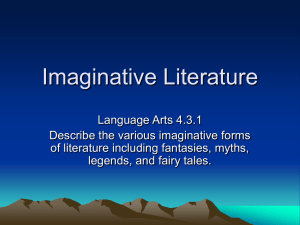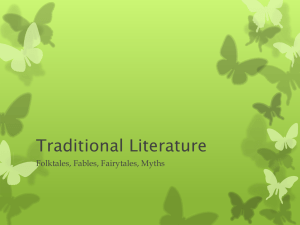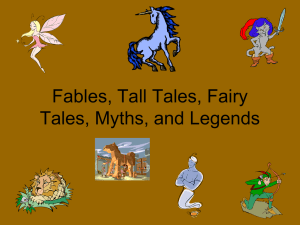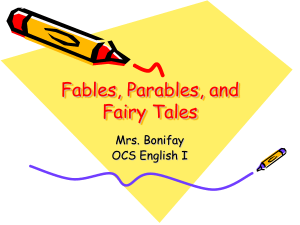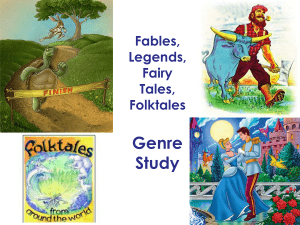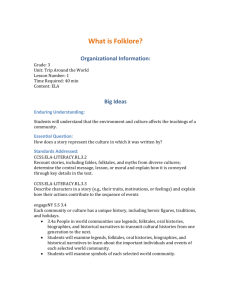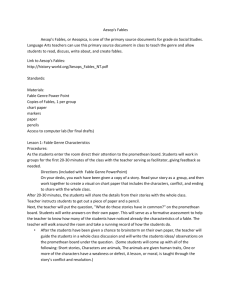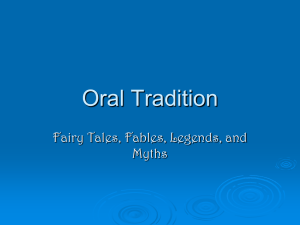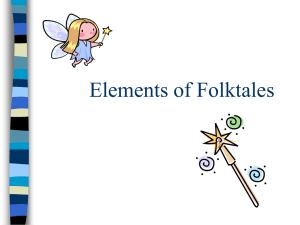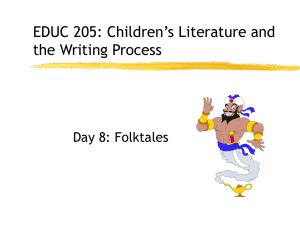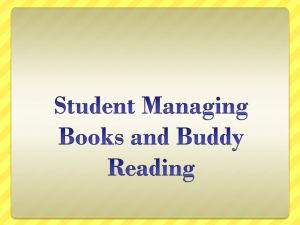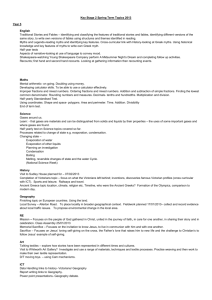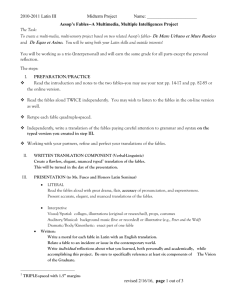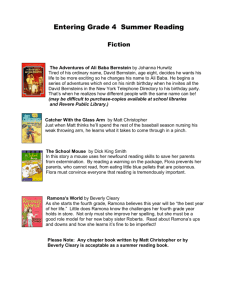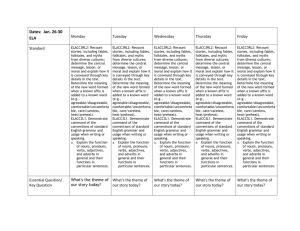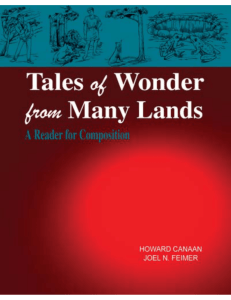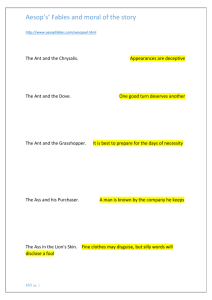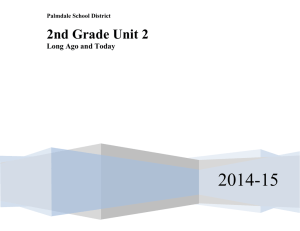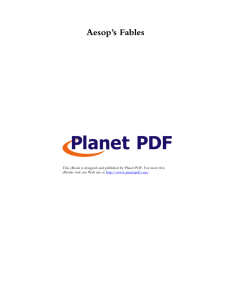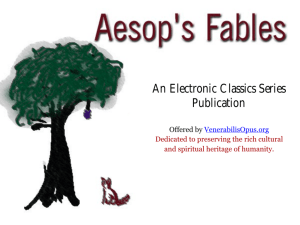Reading Lesson
advertisement
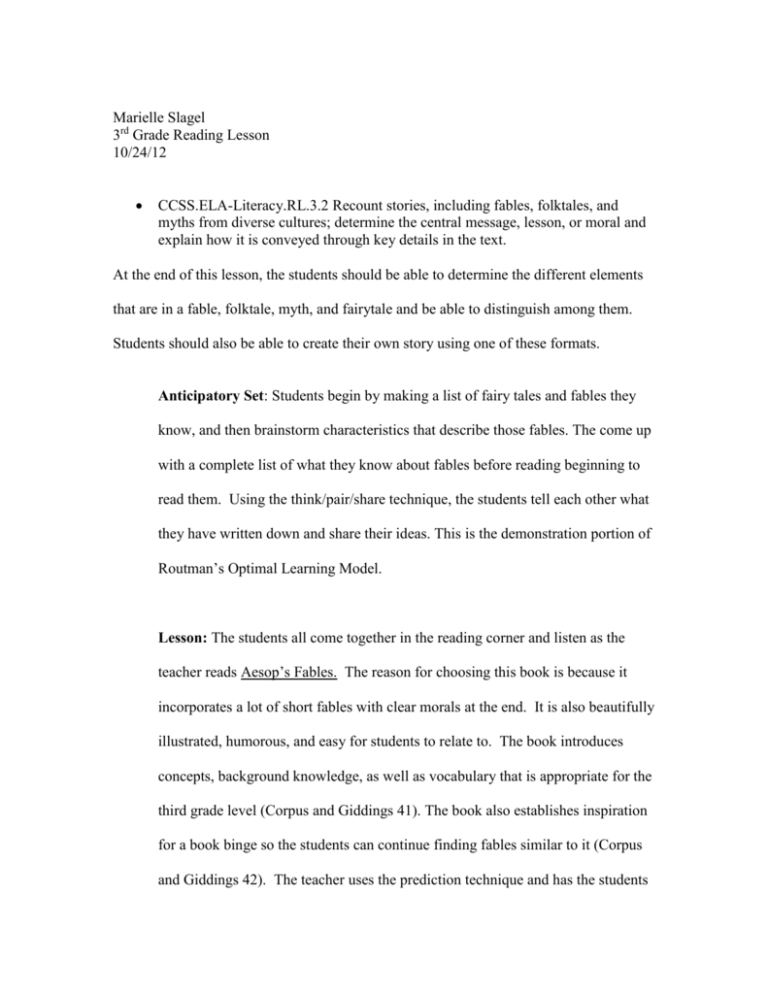
Marielle Slagel 3rd Grade Reading Lesson 10/24/12 CCSS.ELA-Literacy.RL.3.2 Recount stories, including fables, folktales, and myths from diverse cultures; determine the central message, lesson, or moral and explain how it is conveyed through key details in the text. At the end of this lesson, the students should be able to determine the different elements that are in a fable, folktale, myth, and fairytale and be able to distinguish among them. Students should also be able to create their own story using one of these formats. Anticipatory Set: Students begin by making a list of fairy tales and fables they know, and then brainstorm characteristics that describe those fables. The come up with a complete list of what they know about fables before reading beginning to read them. Using the think/pair/share technique, the students tell each other what they have written down and share their ideas. This is the demonstration portion of Routman’s Optimal Learning Model. Lesson: The students all come together in the reading corner and listen as the teacher reads Aesop’s Fables. The reason for choosing this book is because it incorporates a lot of short fables with clear morals at the end. It is also beautifully illustrated, humorous, and easy for students to relate to. The book introduces concepts, background knowledge, as well as vocabulary that is appropriate for the third grade level (Corpus and Giddings 41). The book also establishes inspiration for a book binge so the students can continue finding fables similar to it (Corpus and Giddings 42). The teacher uses the prediction technique and has the students share their knowledge of fairy tales and fables to make predictions during the read-aloud. The teacher then tells the students about other types of stories like fables including fairy tales, myths, and folktales, and makes a chart about how these types of stories differ or are similar to fables. Next, students work together in small groups to read, discuss, and analyze fables, folktales, fairy tales, and myths the teacher has provided. Students will have a choice of which books they choose from a shelf of these types of books. Students will then compile their own list of common elements from these stories in small groups. After compiling a list of common elements, students free write to create their own fairy tale, fable, folktale, or myth. This is the Independent Practice because students are working individually to create their own story. Assessment: Finally, each student presents his or her story with a partner. The partners assess each other and write what type of story their partner used and if they included all the requirements and necessary elements for that type story. This technique encourages peer review and allows the teacher to assess if the students grasped the concept based on what they learned from each other. The effectiveness of my lesson will be clear through the stories that the students create and write as well as their partner’s evaluations. The students will turn in a hard copy of the stories as well as the evaluations so it will be obvious when the teacher looks back on the stories if the students grasped the concept or not. Differentiation: I will differentiate my process according to my students learning interests. Size: Giving student only one specific book to work with that is very similar to the original read aloud Time: More time to create their own story Level of Support: In a peer group when writing story and analyzing story types. – Have mentors who understand the concept better Extra help in when creating story from teacher Option of reading story to a single partner or read each other’s story Input: Model story types and teacher writes his/her own story example Create a “Classifying Stories” visual chart for visual learners Difficulty: Have student write a paragraph instead of an entire story Output: Have students tell a story verbally instead of writing it down Participation: Have student read classmates stories silently to themselves instead of writing their own Strengths I have not used this lesson on children, but if I did, I assume the strengths would be reading Aesop’s Fables as well as giving the students a choice in the book that they want to analyze following the story. Improvements I could improve this lesson by narrowing down the amount of choices and focusing on one specific genre such as fairy tales. Differentiation for General Ed To differentiate this lesson, I could give students only one genre to focus on. I could also talk about the opening sentence of a story and compare them with books from the same genre to show how important an opening sentence is to grasp a reader’s attention. From there, I could have the students write a few opening sentences from a certain genre instead of an entire story. Adaptation for a Specific Disability For a student with ADHD, this lesson would work because there is a read aloud at the beginning that is very engaging. I could have this student come up and hold the book or turn the pages to keep him or her interested in the lesson. I have not used this lesson with students yet, but I think it would be very beneficial to do in the future. Students typically really enjoy learning about books in genres that are different than the ones they are used to seeing. I foresee the students really enjoying writing their own stories using their writer’s voice as well.
